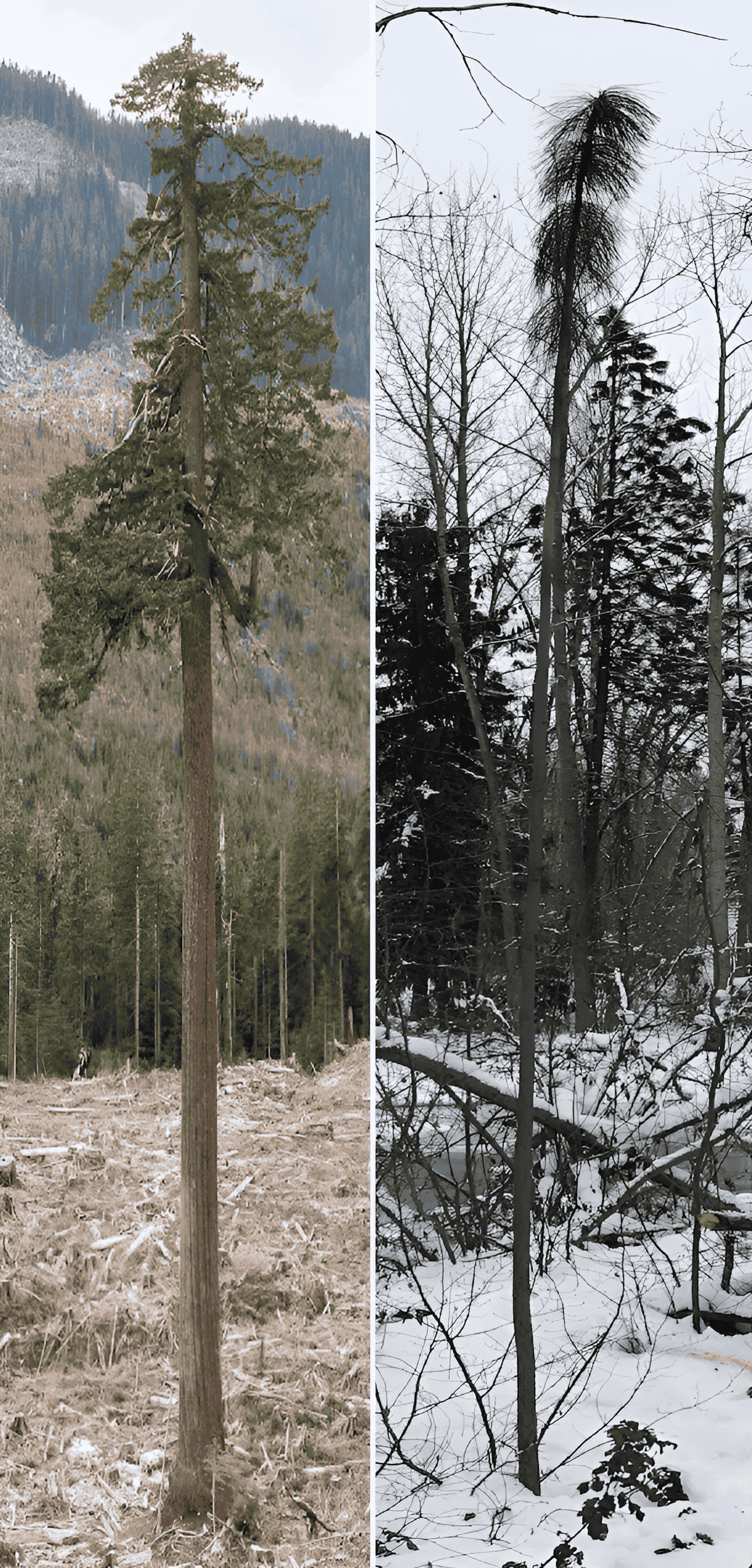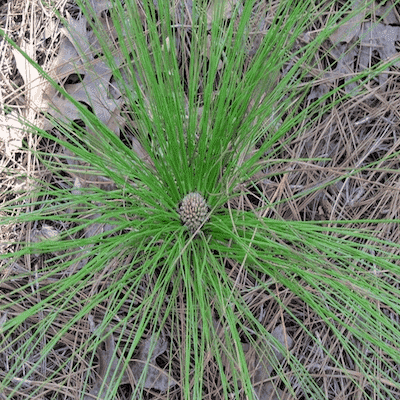Softwoods
A forest is a carbon bank, every tree a deposit.
The term "tree seedlings" was coined over a century ago to describe the cultivation of young trees on a commercial scale. Over time, significant innovations have enhanced productivity in nurseries. Originally, seedlings were grown outdoors in cultivated rows of natural soil and were planted and harvested manually. By the 1950s, the propagation of seedlings from tree seeds became mechanized, increasing efficiency and scale. In the late 1960s, seedling propagation shifted indoors, allowing growers to control the environment. By the 1970s, advancements in growing trays enabled the cultivation of large volumes of seedlings at high density, making the process highly profitable.
The tree seedling industry expanded significantly with the advent of government reforestation programs and tax incentives encouraging logging companies to replant harvested areas, particularly on public or crown land. By the 1980s, private companies began cultivating multi-year hardwoods and softwoods to meet the growing demand for larger, more mature trees. These taller seedlings served the landscape market, catering to homeowners and commercial projects.
Today, tree seedlings are grown in three primary formats for both wholesale and retail markets:
Tree seedlings, regardless of type or size, play a crucial role in various applications, including reforestation, afforestation, landscaping, windbreaks, erosion control, rewilding, tree plantations, climate change mitigation, and ecosystem restoration.
Tree seed propagation involves various methods depending on the species, including industrial grow trays, bags and pot containers, open field cultivation, cuttings, and grafting. Each method is designed to optimize growth and prepare seedlings for specific applications like reforestation, landscaping, or commercial tree plantations.
The choice of propagation method depends on species, site conditions, and the end purpose of the seedlings, with each method offering unique benefits and challenges.
For timber investors, ROI is paramount. Time to harvest significantly influences profits. Planting 10-foot-tall, branch-free tree seedlings can reduce harvest cycles by up to 10 years, enabling returns in 30 years instead of 40 for hardwoods and in 20 years rather than 30 for softwoods.
Margins for plug and bare-root seedlings are slim due to high risks like disease or canceled contracts, requiring growers to produce seedlings in massive volumes for profit. In contrast, growing tall saplings is far more lucrative. Starting with a 1- or 2-foot seedling in a proprietary grow pot, growers can cultivate 10- to 15-foot, branch-free saplings worth hundreds or even thousands of dollars each, compared to pennies for smaller seedlings.
Tall saplings provide numerous advantages, including faster ROI, higher transplant survivability, minimized foraging damage, ecosystem restoration, erosion prevention, and carbon sequestration.
Traditional plug seedlings often struggle with transplant shock due to underdeveloped roots, leading to high mortality rates. Tall saplings, with robust root systems, adapt quickly to new soil, achieving nearly 100% survivability a year after transplant.
Deer and other animals often damage young tree plantations by grazing on branches. Planting 10-foot-tall saplings ensures branches and tips are above reach, protecting trees from significant damage during their vulnerable early years.
Tall saplings expedite ecosystem recovery in areas damaged by land clearing or fire. Their rapid canopy development provides shade, promoting understory growth and biodiversity, while stabilizing the ecosystem within years instead of decades.
Reforestation after fires often faces erosion challenges. Planting tall saplings with horizontal trenching techniques retains soil, mitigates runoff, and quickly establishes forest cover to protect landscapes from further damage.
Wild trees often have bent trunks and low commercial value. By starting with tall, straight saplings, growers can produce valuable hardwoods within 30 years, significantly reducing the wait time for profitable harvests compared to conventional plantations.
A forest typically takes 12 years to develop a canopy capable of capturing one ton of CO2 per acre annually. Tall saplings reduce this timeline to just 3 years, offering a faster solution to combat climate change and meet global carbon reduction goals.
Tree Plantation nuseries grow tree seedlings that are tall, straight and branch free most of the length of its trunk. The photo below shows one of our tall pine tree seedlings 4 years after transplant. It has a 3 inch caliper and a height of 27 feet. It is almost entirely branch free, which means at harvest in 20 years or so, this tree will have knot-free wood and produce valuable grade 1 veneer or timber.

Our Pyramid Tree Pots are designed to grow trees in the same pot for up to 20 years. Their pyramid shape conforms to the natural root habit of a tree, which is bottom half hourglass shaped. The shape encourages superb root development and rapid terminal branch growth, which will determine the height of the tree. The root shape eliminates the need for after transplant tree supports and guide wires. Pots are easily assembled and disassembled for a quick plant and harvest. The formed root and long stem of the tree facilitates ease of transport by container, truck, or trailer. Tall trees are transplanted using a PTO tractor mounted post hole digger. Pyramidal Tree Pots are used once and recycled after the tree is harvested.
Our tree pallet propagation system grows tree seedlings 10 feet more in height over a span of between 5 or 6 years. The system features parallel rows of vertical 6-inch-wide x 36-inch-deep tree pots 20 feet in length. Each length grows 40 trees, and several lengths are laid out. One adjacent to the other on top of a rubberized, weatherproof ground cover. An elevated drip irrigation system waters the trees. Periodic pruning is achieved by accessing elevated walkways between the rows of tree seedlings. The tree pallet system is reusable and recyclable.
We would like to build a network of tall tree growers across the country. A network of growers will eliminate the long-haul shipment of trees that can be grown locally. It also creates a home-based business opportunity that can earn a significant income. The only requirement is that you have a small plot of land, a little money, some time, water and are willing to grow a few of the trees for us – the rest you can sell for whatever the market will bear – commercial tree species are in high demand. We supply everything else, installation, pyramid pots, soil, seedling starts, irrigation lines and attachments.
A breakthrough in desert tree irrigation, the Deep Root Irrigator is a revolutionary technology designed to deliver water directly to the roots of trees growing in arid conditions. Engineered from high-grade iron, the irrigator is permanently embedded below grade near the tree, where it channels water precisely to a depth of four feet. This system ensures that moisture reaches the deepest roots, promoting healthy growth while minimizing water waste. Remarkably efficient, the Deep Root Irrigator can saturate a five-foot diameter area around the tree in just 20 minutes, making it an ideal solution for regions with scarce water resources.
The irrigator’s design offers dual benefits. Over time, the iron structure naturally decomposes, slowly releasing trace nutrients into the soil and further enriching the tree's root environment. This process enhances the long-term health of the tree while reducing the need for chemical fertilizers. The deep placement of water also reduces surface evaporation, ensuring that every drop counts in water-limited desert ecosystems. This innovative approach, developed by Tree Plantation, a division of New Leaf Technologies LLC, not only conserves water but also helps establish robust trees capable of withstanding harsh desert climates, making it a game-changer for sustainable desert reforestation and agriculture.
Partner with us in a land management project to repurpose agricultural lands into appreciating tree assets. We have partnered with growingtogive.org, a 501c3 nonprofit, to create tree planting partnerships with land donors.
We have partnered with growingtogive.org, a Washington State nonprofit to create a land and tree partnership program that repurposes agricultural land into appreciating tree assets.
The program utilizes privately owned land to plant trees that would benefit both the landowner and the environment.
If you have 100 acres or more of flat, fallow farmland and would like to plant trees, then we would like to talk to you. There are no costs to enter the program. You own the land; you own the trees we plant for free and there are no restrictions; you can sell or transfer the land with the trees anytime.
Copyright © All rights reserved Tree Plantation


